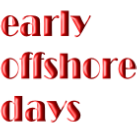© 2014-

Early Offshore Days (1)
Daily Mail yacht
Possibly the first plan f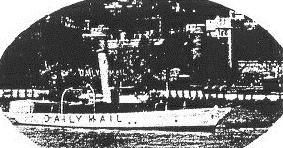 or an offshore radio station came in the infant years of broadcasting itself when the owners of the London Daily Mail chartered a steam yacht, Ceto, as part of a promotional campaign. The newspaper planned to use the vessel to broadcast, from outside the three mile territorial limit, music and advertising announcements for itself and its sister publications the London Evening News and the Sunday Dispatch. The idea was conceived by the Mail's Director of Circulation and Publicity, Valentine Smith.
or an offshore radio station came in the infant years of broadcasting itself when the owners of the London Daily Mail chartered a steam yacht, Ceto, as part of a promotional campaign. The newspaper planned to use the vessel to broadcast, from outside the three mile territorial limit, music and advertising announcements for itself and its sister publications the London Evening News and the Sunday Dispatch. The idea was conceived by the Mail's Director of Circulation and Publicity, Valentine Smith.
With a transmitter on board, the Ceto sailed from Dundee in Scotland for trials during the early summer of 1928. However, technical difficulties arose when the swell of the sea began to affect the broadcast signal, making reception on land virtually impossible. The slightest movement of the yacht, even in a calm sea, affected the primitive broadcasting equipment and finally the idea of transmitting programmes had to be abandoned.
Undaunted by this setback Valentine Smith then arranged for German sound equipment manufacturers, Siemens Halske, to supply four loudspeakers, each weighing six and a half hundredweight (330Kg), which were mounted on to the Ceto's superstructure. With this equipment in place the yacht sailed around Britain anchoring off holiday resorts and coastal towns 'broadcasting' gramophone records of popular music interspersed with advertisements for the three newspapers. Stephen Williams, who later worked for Radio Normandy and Radio Luxembourg, was in charge of presenting programmes and making the commercial announcements from on board the Daily Mail yacht.
The Ceto planned to leave Dundee on 25th June 1928 with a civic send off by the Lord Provost, Mr William High. However, due to technical adaptations needed to the on-
On her outward journe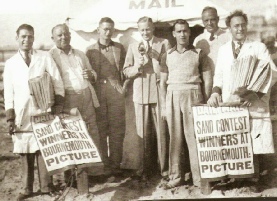 y the vessel sailed down the east coast of Britain, through the Channel, along the south coast and up the west coast as far as the Isle of Man. The return journey was used for the Ceto to revisit many resorts and towns where her original concerts had been a huge success.
y the vessel sailed down the east coast of Britain, through the Channel, along the south coast and up the west coast as far as the Isle of Man. The return journey was used for the Ceto to revisit many resorts and towns where her original concerts had been a huge success.
At night the Ceto was illuminated by over 1,500 lightbulbs, spelling out the words DAILY MAIL in red and white, while two 1,000 candlepower searchlights were used to illuminate seaside promenades during concerts 'broadcast' from the ship. Local Mayors and other dignitaries also came on board at virtually every town or resort visited by the Ceto to welcome visitors and holiday makers.
One of the local dignitaries was even responsible for the first 'live' performance from the Ceto on 19th July 1928. Councillor Robert Stokes (Chairman of Poole Borough Council's Parks Committee) came on board the vessel with other local councillors and sang two songs during one of the concert programmes. 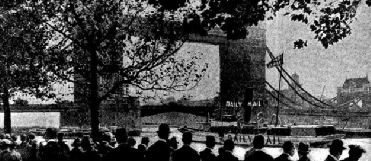
The Ceto's role as a broadcasting station ended on 1st September 1928 when, after ‘broadcast’ from a position near Tower Bridge on the River Thames and an additional concert at Greenwich, the ship was taken to Purfleet. Here all the broadcasting, studio and generating equipment was dismantled and the yacht returned to her former role as a pleasure vessel. Altogether during her ten week cruise the Ceto covered over 4,000 miles, visited 87 seaside resorts and coastal towns and 'broadcast' 300 concerts.
Although originally intended to be a broadcasting station, because of the technical difficulties experienced during the trials off Scotland, the Ceto really only 'shouted' programmes and commercial messages to audiences in relatively small areas along the coast.
Valentine Smith's original concept, however, demonstrated that right from the beginning of radio broadcasting history the theoretical possibility of transmitting programmes, quite legally, from outside a nation's territorial limit had been identified. Only the lack of sufficiently sophisticated broadcasting equipment at the time prevented this pioneer from succeeding, but the principle Smith had identified was to remain fundamental to the operation of offshore radio stations for the next 63 years.
The Daily Mail yacht, Ceto
Ceto ‘broadcasting’ her concert at Tower Bridge on 1st September 1928 Photo: Daily Mail
Stephen Williams (centre) with some of the Daily Mail team and news vendors at Bournemouth
Photo: Daily Mail





Ground
Floor
Back to


State Monopolies and International Agreements









Back to Gallery index

Early Offshore Days (2)
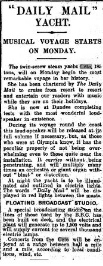
Daily Mail
23rd June 1928

Click images to enlarge

Daily Mail
4th July 1928
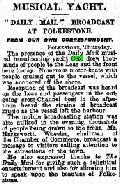
Daily Mail
13th July 1928

Daily Mail
23rd July 1928
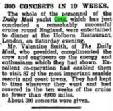
Daily Mail
3rd September 1928
